We’re chattering our way along a trail through an old railway cutting, when we’re startled by a loud squawk and a commotion in the vegetation atop the cliff beside us. We’ve already looked up to see what’s going on when Daryl, our guide from (and owner of) Blue Mountains Guides, points out the two Lyrebirds that are causing the ruckus.
Need to Know
This tour can be booked via Blue Mountains Guides (1300 300 755). Medium fitness is required to undertake the trail. Tours are heavily customised and pick-ups can be organised. Lunch is included. The drive from Leura to the Glow Worm Tunnel takes around an hour (much of it on dirt roads) but it’s well worth the trip.
Visitors looking for more walks, Aboriginal Discovery Tours, or information about Blue Mountains National Park, should check out the NSW National Parks and Wildlife Service online or contact them on 1300 072 757. Information on booking campsites is also available on the site.
Walk Details
The Glow Worm Cave
Length (km): 2.5 km.
Time (hrs/min): 2 hrs.
Grade: Easy.
Return / Circuit / One-Way / Partial Circuit: Return.
Closest Town: Lithgow.
Wolgann View Canyon (aka The Dry Canyon or Nobles Canyon)
Length (km): approx. 5 km.
Time (hrs/min): 2 hrs 30 mins.
Grade: Easy.
Return / Circuit / One-Way / Partial Circuit: Return.
Closest Town: Lithgow.
“Ever seen a Lyrebird before?”
“No, never,” Lori says excitedly.
“I have, but not this close-up,” I add.
We watch them flap around in the vegetation for a few minutes, unsure if they’re fighting or mating, before continuing on our way. It’s not the Lyrebirds we’re here to see, after all, but another very different kind of beautiful creature.
Soon the cutting narrows further and the rainforest vegetation grows thicker, leaving us rock-hopping back and forth across a small stream to keep our feet dry. We’re only about 15 minutes from the car when the entrance of a disused railway tunnel comes into view; deep, black, and partially hidden by fallen trees and the massive branches of an unbelievable number of tree ferns.
We stop beside an old wooden sign that leans against a wet, mossy rock-wall – “Give the worms a go. Keep the lights and noise low. Please don’t touch the glow worms.” Daryl fishes around in his backpack, pulling out three torches and handing us each one, before we make our way into the darkness.
After advising us to keep to the narrow rise at the side of the tunnel to keep our feet dry, Daryl gives us a brief history of how it (and the cutting we’ve been following) came to be.
“The railway line was built in the early 1900’s, to connect the Shale Works in Newnes back to Sydney,” he explains.
He tells us that the railway was dismantled, and the 400 metre long tunnel abandoned, in the 1940’s, when the mining venture became unviable. Now it’s become one of the most popular tourist spots in the area.
It’s slow going once we’re away from the well-lit tunnel entrance. We tread carefully along the rocky path, searching the ground below with our torches to safely execute every step. Although it feels longer, we must only be about 100 meters in when Daryl tells us to stop and cut the light.
We stand silently and, as our eyes adjust to the near complete darkness, the tiny luminescent blue dots come into view all around us, concentrated on the tunnel wall opposite. The longer we stay silent, the more there seem to be, until they resemble a perfect night-sky; their own miniature version of the Milky Way galaxy winding through the middle.
“Woah,” I whisper, amazed at the best glow worm display I’ve ever seen.
With torches back on, we continue further into the tunnel while Daryl explains these amazing creatures. They’re actually the larvae of something called the fungus gnat, he tells us, and the blue glow is the result of a chemical reaction in their tiny bodies.
He stops again and shines his torch briefly on a dark section of the tunnel wall. We come closer and can see the larvae hanging in a sticky looking web.
“The glow attracts their prey; mosquitos and other insects come along and get stuck in the web,” he tells us.
A little further along we reach the knee of a bend in the tunnel, where we can’t see the light from either end. Daryl tells us to turn the torches off again, and we stand for a minute in complete darkness, taking in the eeriness of it all.
After stopping a couple more times to enjoy the glow worm display, we find ourselves at the tunnel’s north end. I’m a little disappointed that it’s over until I’m struck by the soft green light of the rainforest beyond, dense with bracken fern and tree ferns, some as tall as two or three metres.
We stroll for another few hundred metres along a rocky creek before we climb up onto a rise and sit down for a snack and a chat. Daryl’s already made us feel so comfortable that we feel like we’re out hiking with a mate, and over lunch we continue our chats about everything from nature and conservation to relationships and raising children. His attitudes towards parenting are inspirational. His boy is a similar age to ours, and he tells us how they hike, canyon, and rock-climb, and how he wants to run a tour for kids with his son as the guide. Our chats leave both Lori and I feeling like we’ve gained much more from this trip than just nature facts.
After lunch, we retrace our steps back to the car. As Daryl has done since picking us up at our hotel, he asks questions to gauge how he can make this the best possible day out. Tours with Blue Mountains Guides don’t just follow a set schedule, he explains. He wants to know what people have already seen and heard, and how challenging or relaxing they’d prefer their day to be. He even tells a story of driving a client back to Sydney to catch a flight, after not getting them to the train on time. He offers us another stop at a nearby dry canyon and, being unaware that there was such a thing in the Blue Mountains, it’s an easy decision.
***
Wattle trees in flower add a splash of yellow to the tall, open forest surrounding us. On each side of the walking track, the ground is thick with bracken fern.
We’re weaving our way between some of the pagoda rock formations that gave Gardens of Stone National Park its name. Created by the erosion and weathering of the sandstone outcrops that dot the landscape here, and covered in moss and lichen, they’re so ornate that they could almost be mistaken for the ruins of an ancient city.
“Oh wow,” I seem to repeat over and over. There I go again with my eloquence.
After half an hour of easy walking, I notice the track swinging around toward two of the largest pagodas. We slowly descend as their sandstone walls rise around us and soon the sun is mostly blocked out. We’re struck by the thick smell of wet and rotting vegetation.
“Smell that?” I ask Lori. “That’s got to be one of my favourite smells, like, ever.”
The distance between the rock walls surrounding us increases again and I start to wonder if that’s it, but then suddenly we’re scrambling down a rocky descent that leads to another section of canyon; this one even deeper and darker again.
I utter “Oh wow” with increasing frequency as we make our way through this narrow, twisting slot, pushing giant tree fern branches aside to follow the track. In the narrowest, darkest sections of the canyon, I can easily touch both walls at the same time. There are no straight cliffs here, and I have to duck and weave to avoid bumping my head.
I realise that Daryl hasn’t said much for a while and that he’s walked ahead a little bit, then I realise why – he wants to give us space and silence to take it all in. When I stop to take a photo, Lori catches up and I notice her face beaming as she stares around at every detail of the canyon. She notices me looking and puts her arms in the air, and then her palms together in front of her, gesturing her gratitude to this incredible place. Neither of us have any words, but none are necessary.
The canyon opens up again and we take a seat on a pile of fallen rocks, which appear to have fallen from the opening of the canyon above. As I inhale my delicious wrap, we discuss what to do next. A short walk further on is a view over the Wolgan Valley to Donkey Mountain, and there’s also a swim at a popular local swimming hole on offer on the way home, but Lori and I are both exhausted and decide nothing is going to outdo the Dry Canyon anyway. It’s time for some much-needed relaxation back in Katoomba.
Looking for the rest of the series? You can find all 5 posts in the series right here.
Eat
Housed in a converted auto-repair shop, Leura Garage Café & Restaurant (84 Railway Parade, Leura / Open 7 days, 12-5) is without a doubt my favourite eatery in the Blue Mountains. The staff are friendly and accommodating, and the food, sourced locally as much as possible, is absolutely to die for. We feast on tapas-style dishes like semi-dried tomato and parmesan arancini, a platter of roasted and smoked meats, sticky chicken wings, and grissini pizza dipped in olive oil and Leura Garage’s own pomegranate balsamic. Much to my excitement, Lori likes a beer these days, and we fall in love with one of their tap beers, the Badlands Pale Ale (brewed in Orange). We love it here so much that we can’t resist our final opportunity to try some different dishes, and return for a second night in a row.
Victory Café (17 Govetts Leap Rd, Blackheath / Open 7 days, 8-4) is our breakfast stop before a few of our days out hiking. They make a delicious coffee, and their yummy breakfast burger is the perfect fuel for a day in the bush. Once again, the staff are lovely and very accommodating, but this seems to be the trend almost everywhere in the Blue Mountains.
Blackheath Continental Deli (32 Govetts Leap Road, Blackheath) seems to be the go-to place for a packed lunch when hiking, so much so that they even have a roll on the menu called the “Bushwalker”. It’s a 10 out of 10 – would eat again.
Sleep
Our favourite accommodation during our week in the Blueys is Waldorf Leura Gardens B&B Resort (02 4784 4000 / 20-28 Fitzroy Street, Leura). Set on magnificent landscaped gardens, they even offer guided tours with their resident gardener (check with reception for dates and times). I take full advantage of the pool (probably why it’s the favourite), which the balcony of our spacious, modern room overlooks. There’s nothing like a swim after bushwalking on a summer day. We also enjoy a late night game of table-tennis and pool. The pool table is a little worse for wear, but I play so poorly that it makes no difference anyway. The resort has two restaurants but we only make it to one of them, for their excellent buffet breakfast.
Blackheath Motor Inn (02 4787 8788 / 281 Great Western Highway, Blackheath) has a rustic, mountain cottage feel but still feels new. Lori and I feel very cosy in our room, and love that we’ve got a back-door leading out to the garden and our own table and chairs. It’s also great being a short walk from The Gardners Inn, when we’re in need of a post-walk beer. The owners, Senga and Eddy, are a great source of local knowledge, especially for bushwalkers.
The Mountain Heritage Hotel & Spa Retreat (02 4782 2155 / Corner Apex & Lovel Street, Katoomba) sits on a hill overlooking Katoomba and some rooms, fortunately ours included, have views over the Jamison Valley. Despite hosting a wedding on the night of our stay, staff manage to make us feel like we’re their only guests.
Redleaf Resort (02 4787 8108 / Corner Evans Lookout and Valley View Roads, Blackheath) is perfectly located for hikers, just down the road from Evans Lookout, trailhead for the Grand Canyon Walk and the cliff-top track to Govetts Leap, among others. They have a games room, heated undercover pool, and playground.
During our stay in the Blue Mountains, we were guests of Blue Mountains Lithgow & Oberon Tourism, NPWS, Tread Lightly Eco-Tours, High & Wild Adventures, Scenic World, and Blue Mountains Guides. As is always the case, this has no influence over the opinions I present on Bushwalking Blog.
Have you checked out the Blue Mountains? Visited the Dry Canyon or Glow Worm Tunnel? Do you have any experience with Blue Mountains Guides? If you’ve got any tips or tales to tell, please let us know by commenting below.

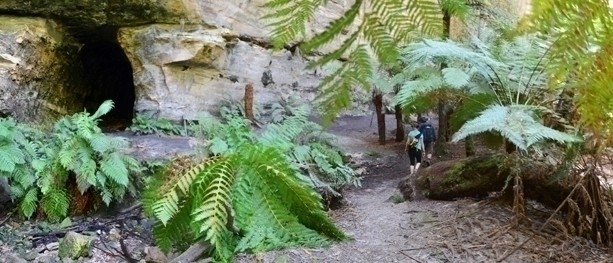

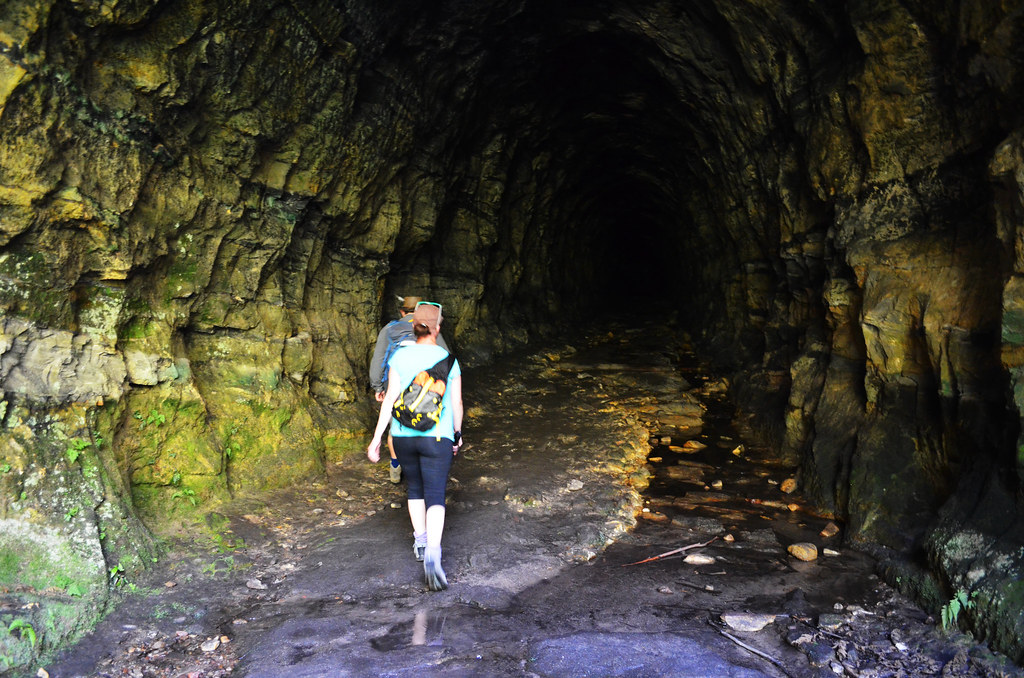

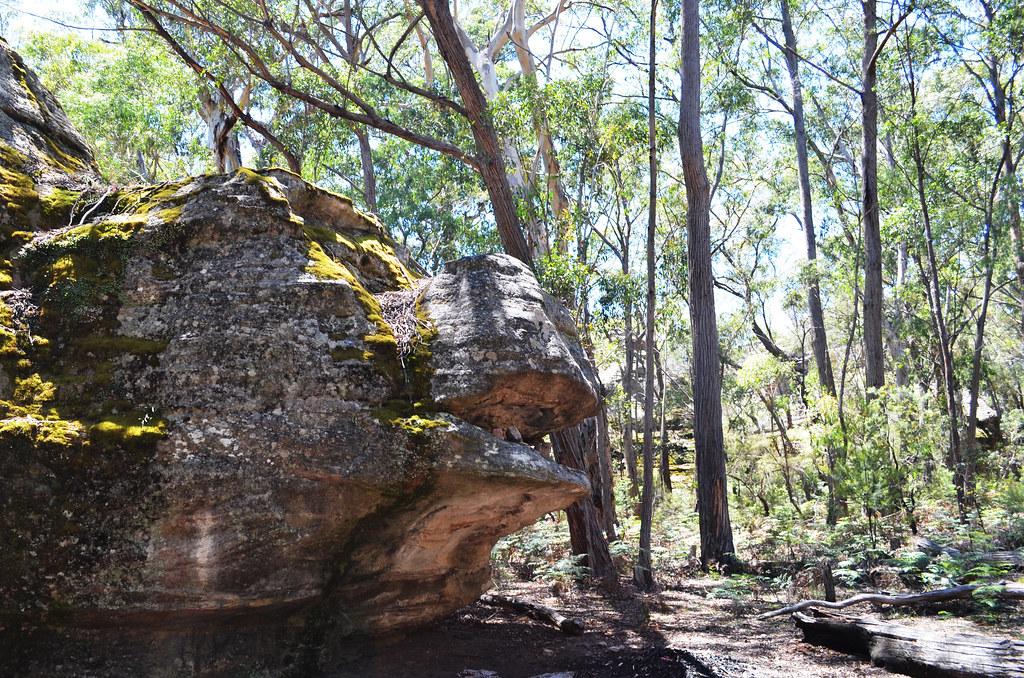

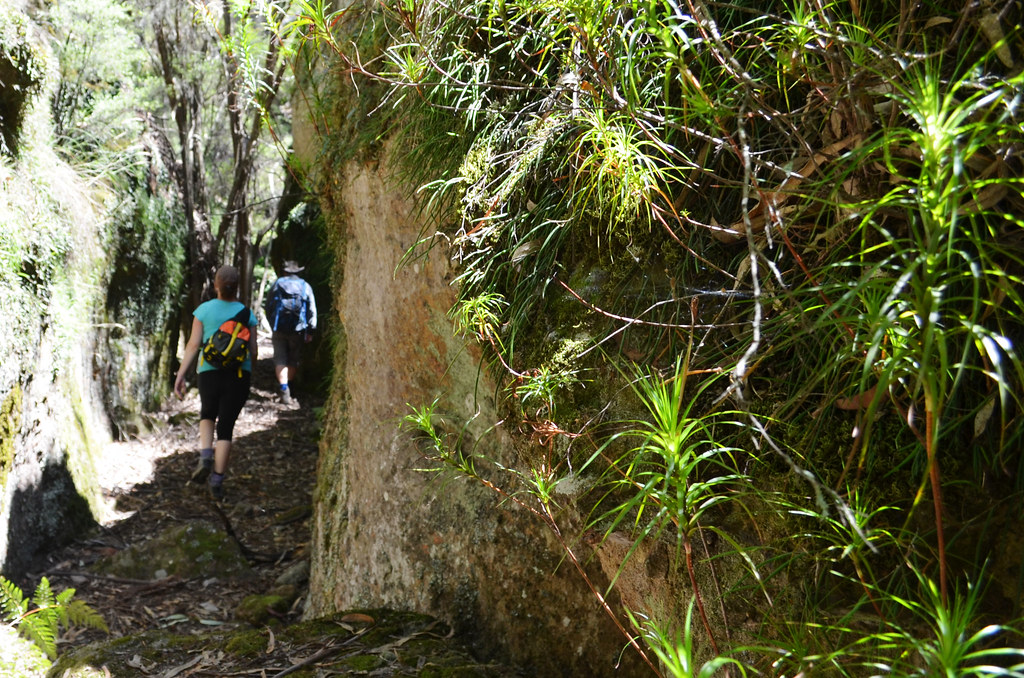
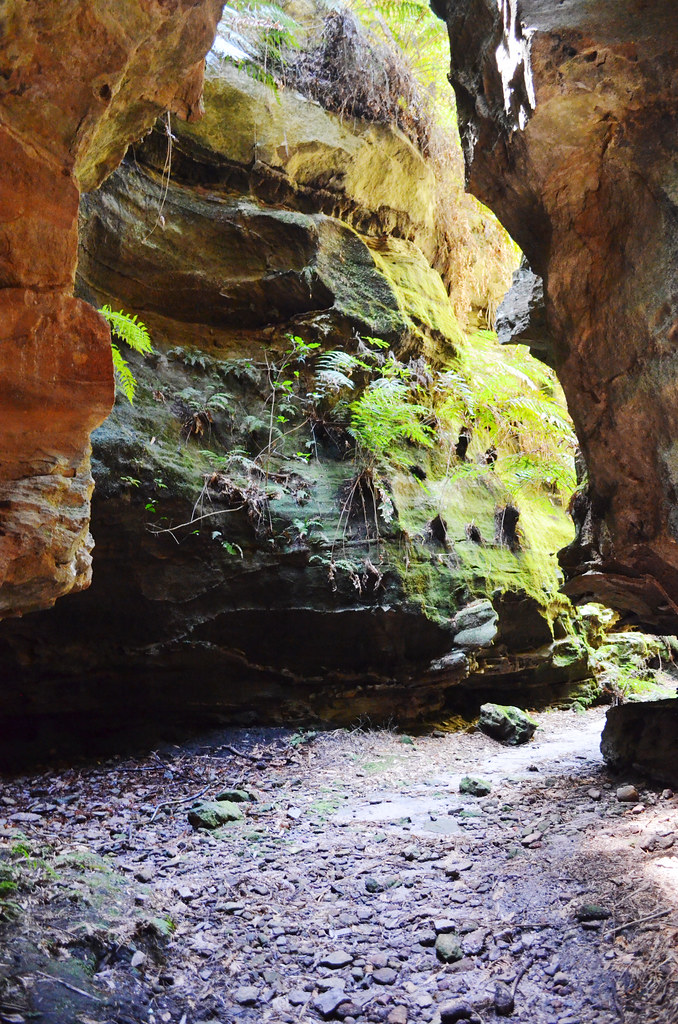
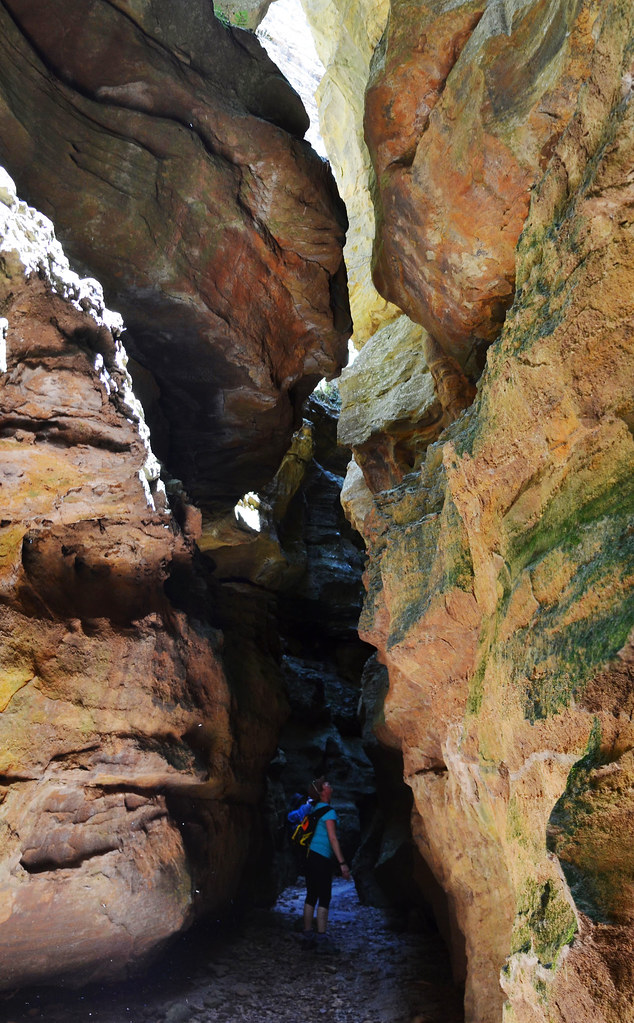




Hi, we are planning to head to the glow warm tunnel and dry canyon this weekend, just wondering where the swimming hole is that you mentioned you skipped?
Thanks for any info, Katie.
Hi Katie,
Really sorry but I don’t know. All I know is we drove past it on the road between the highway and the glow worm cave.
Cheers
Neil
Oh Neil, I actually got a bit teary when you described how you and Lori felt as you went through the canyon areas and also when you saw the the glow-worms. I’m so glad you could experience this together. I’ve never seen glow-worms but after reading this and going to make the glow worm cave at Springbrook National Park a priority. I love the way you shared the magical effects of nature with us. Another great post about the Blue Mountains. What a fantastic place to visit!
I must be doing something right if I’m making you teary! 🙂 Yep, it’s another one of those beautiful things that we’re lucky to be able to do together. I’m eternally grateful! Definitely go check out some glow worms at Springbrook! That would be awesome. I shall look forward to reading about it.
Thanks for the comment.
Cheers
Neil
Oh wow! I can understand your enthusiasm about this place Neil, it looks lovely. I have always been interested in visiting Newnes, did you see any of the historic building ruins while you were there? Dry Canyon and those sandstone pagodas look beautiful too. I remember seeing some of those sandstone formations near Dunns Swamp on the edge of Wollemi National Park a few years ago. I am pretty sure a few “oh wows” were said at the time! Nature sure does produce the most amazing things.
We didn’t actually get to see the town of Newnes, unfortunately. I’ll have to check it out next time.
That sounds right about Dunns Swamp. Apparently there are about 600 square kilometres of those pagoda formations around Wollemi and Gardens of Stone.
Cheers for the comment!
Neil
A dry canyon… something to add to the list for next time. Along with so many other things! And glow worms are always amazing to find, the way they seem to create miniature starry skies in dark caverns. Both fantastic places. Thanks for sharing! 🙂
Thanks for reading (and commenting), Dayna! The dry canyon is a must visit. It was something else.
Cheers
Neil